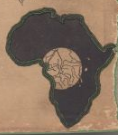Balladeer’s Blog continues reviewing the 1927 book Trader Horn, the quasi-autobiographical account of the British Trade Agent Alfred Aloysius Horn’s adventures in Africa during the late 1800s. For Part One click HERE.
 PART FOUR – We pick up this time with Trader Horn’s reflection on how the British and German firms in Africa dominated the European trade in ivory and rubber, while France was a distant third. There were whispers that the French (whom Horn referred to far more insultingly than he ever referred to the indigenous Africans) were strategizing about using their Colonial Governments to limit the success of Great Britain and the German Empire wherever they could.
PART FOUR – We pick up this time with Trader Horn’s reflection on how the British and German firms in Africa dominated the European trade in ivory and rubber, while France was a distant third. There were whispers that the French (whom Horn referred to far more insultingly than he ever referred to the indigenous Africans) were strategizing about using their Colonial Governments to limit the success of Great Britain and the German Empire wherever they could.
The French and Belgians also pressed further and further into Central Africa, encountering tribes who had literally never seen white people before. Alfred’s employers at Hatson & Cookson kept him closer to the coast, but he added the Como, Remwe, and Belagona Rivers to his trading route.
All the trading firms in Africa at the time had their expeditions fired upon by Fan tribesmen, and Trade Agent Horn’s were no exception. As the years rolled by, Alfred was moved to a higher position with his firm.
To reach this new posting, Horn traveled by ship to Cape Lopes, located among Cerigu tribes. At the time, the Cerigus were still making their living mostly by piracy and by slave-trading with non-western nations.
 Further inland were more hospitable indigenous people like the Ivilis and Shekhanis. The paddle-wheeled riverboat that our man was now on passed by the sprawling trade depot of the Carl Woerman firm, Germany’s biggest outfit in the region.
Further inland were more hospitable indigenous people like the Ivilis and Shekhanis. The paddle-wheeled riverboat that our man was now on passed by the sprawling trade depot of the Carl Woerman firm, Germany’s biggest outfit in the region.
At his new posting, Horn was greeted by Agent-in-Charge Sinclair and ran a staff overseeing the export of ivory, ebony, plus ball, tongue and flake rubber. From this new locale, Alfred was busier than ever.
When that year’s rainy season was over and the rivers fell a bit, business slowed to a trickle and Trade Agent Horn was assigned to survey the Ogowe River from the Hatson & Cookson depot to one hundred miles further inland.
Alfred recalled a coastal tribe ruled by Chief Renchoro, whose son (also named Renchoro) worked as an aide for Horn. The chief’s people had a harsh policy of throwing very elderly females of the tribe into crocodile-infested waters to be finished off and no longer need to draw from the tribe’s resources.
Chief Renchoro was also the man who showed Horn the gravesite of a British man named George T. – Alfred never used the full name in the book. George’s young daughter Nina was supposedly living with a tribe further inland.
 On one of Trader Horn’s next surveying expeditions deeper into the continent he got to see Lake Azingo for the first time. Alfred once again expressed his wonderment at the huge populations of jungle animals, birds, butterflies and monkeys as well as lake seals, whom the natives killed by spearing them.
On one of Trader Horn’s next surveying expeditions deeper into the continent he got to see Lake Azingo for the first time. Alfred once again expressed his wonderment at the huge populations of jungle animals, birds, butterflies and monkeys as well as lake seals, whom the natives killed by spearing them.
Further inland, Trade Agent Horn’s survey expedition encountered the Bimvool tribe and further still the Galoa tribe. Their village contained a skull house for rituals and which was presided over by an Izoga, a holy being who supposedly never died, but this was either an embellishment by Alfred or the Galoas were pulling his leg.
Horn was told he would have to undergo an initiation ritual to be allowed into the interior of the skull house and he consented to such an initiation in my next part.
FOR THAT NEXT PART CLICK HERE.

I’m off to see if I can find this book. Maybe Gutenberg…
That is one of the best spots!
Great posts as always. I have never heard of Trader Horn before, so I found this to be an informative article. I generally don’t have interest in traders but Alfred Horn’s adventures in Africa seem fascinating to me. Trader Horn reminds me a lot of classic films I have watched about trade in U.S. history. For instance, Trader Horn’s story brough to mind the Oscar-winning film “12 Years a Slave”. Set during the 1800’s, it tells the harrowing true story of an African American man that was sold into the slave trade. One of the best movies I have ever seen. It’s not an easy watch due towards the disturbing subject matter. That being said, I highly recommend it. Here’s why it’s a must-see:
Thanks! I appreciate it!